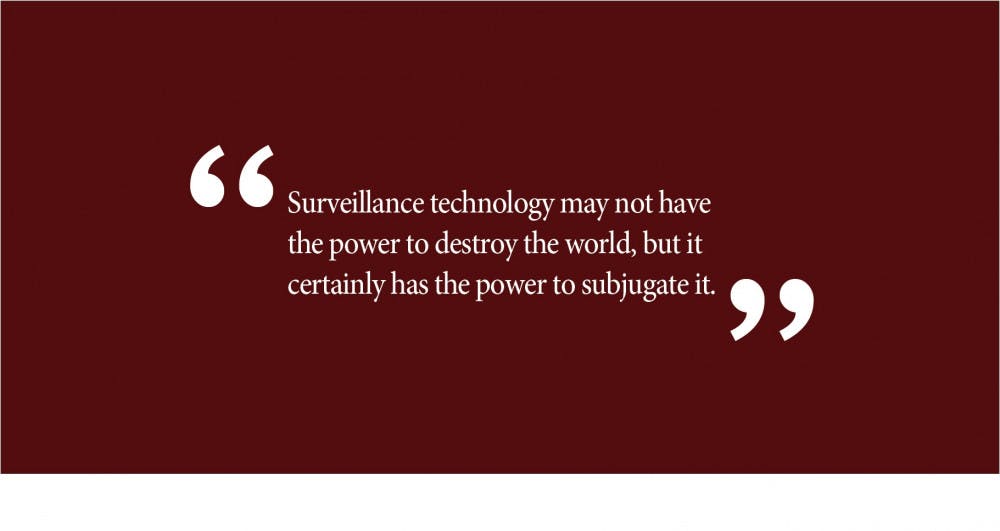“He thought of the telescreen with its never-sleeping ear. They could spy upon you night and day.”
In the fictional province of Oceania, there is a telescreen on every street, in every building, on every wall. These two-way viewing devices allow the “Thought Police” to surveil citizens and ensure that any subversive expression can be immediately suppressed.
Prescient as he was, George Orwell was 35 years early. The year is 2019, and at long last, we’ve arrived in 1984.
It has become thoroughly cliche to declare something Orwellian, but over the last few weeks, videos have surfaced showing protesters in Hong Kong tearing down facial recognition towers — which are essentially tall poles topped with an array of cameras bearing an eerily similar function to Orwell’s telescreens. Using artificial intelligence-driven facial recognition software, the Chinese government has the ability to identify, track and therefore suppress political dissidents. As a result, protesters have taken to covering their faces with masks and using lasers to blind the towers. This is but one moment in a long, shameful history of Chinese civil and human rights abuses in Hong Kong.
And while this example may be the most striking in recent memory, it’s emblematic of a broader issue: the dual uses of surveillance technology and its ever-expanding role in society. The same technology that can help us catch violent criminals is also an invaluable tool in a dictator’s woodshed — one that has the potential to maintain autocratic regimes, clear the way for political repression and destroy civil liberties worldwide. The international community must draw the line between acceptable and unacceptable uses of this technology now, before it’s too late.
It seems hardly necessary to justify the utility of surveillance technology in certain circumstances. If a terrorist makes a phone call, knowing what they say could mean the difference between thwarting an attack or enduring one. But the same technology used to track terrorists can be used to track political opponents as they walk down the street.
So how can we stop the technology from being used in ways that violate civil liberties? One way is to prevent the emergence of the technology to begin with — but it seems undesirable and anyway impossible to stymie technological progress for a long time, let alone forever. The realistic, and necessary, alternative is to regulate its possession and use, similar to the way we regulate nuclear weapons worldwide. Surveillance technology may not have the power to destroy the world, but it certainly has the power to subjugate it.
Some may ask how surveillance technology is qualitatively different from other widely accepted, yet potentially repressive, tools — after all, most wouldn’t call for an international treatise regulating tear gas. And isn’t this just a different, though perhaps bigger, stick?
The difference is the manner in which this technology operates: Surveillance tech is used in the shadows. Its covert nature gives dictators the information necessary to suppress protests before they begin, and by doing so, gives the outside world the illusion of stasis. It is a tool that is effective, in large part, because you can never really be certain when or how it’s being used. For example, in the case of Hong Kong, there is a real possibility that facial recognition technology is being used to identify protesters now, so that when the protests have subsided and the media spotlight is off Hong Kong, the Chinese government can use that database of names to round up dissidents.
The second difference is that surveillance tech is used best when it is used broadly. Necessity dictates its extensibility: If you knew who your targets were, then you could exclusively monitor them. But if the goal is to identify targets, as it almost always is, then you must collect data from everyone — or at least from large swaths of people. This is what is commonly referred to in the United States as bulk collection.
Dictatorships may be the most cinematic scenarios for misuse of this technology, and this form of government is — thankfully — somewhat foreign to the American experience. But it’s not just use by despots and it isn’t just political repression that are concerning about this technology. Consider, for example, the potential utility in law enforcement. Would we really feel comfortable with the government monitoring our every move as we walked down the street, even if it meant that there were fewer burglaries in our neighborhoods? It is the essence of a police state: eternal invigilation. You jay-walk on Monday, and by Friday there’s a citation in your mailbox. In such a world, wearing a mask in public is the contemporary equivalent of putting a piece of tape over your laptop’s camera.
The best time to regulate this technology is before its use becomes ubiquitous — in other words, now. Those nations who value the preservation of civil liberties must pressure those without a similar predilection to rein in this technology. Otherwise, governments around the world will have the ability to construct a daily record of where you’ve been, how long you were there and who you were with. And, on that day, the concept of privacy becomes but a quaint memory—there will be no hiding from Big Brother.
Andrew Reed ’21 can be reached at andrew_reed@brown.edu. Please send responses to this opinion to letters@browndailyherald.com and op-eds to opinions@browndailyherald.com.





